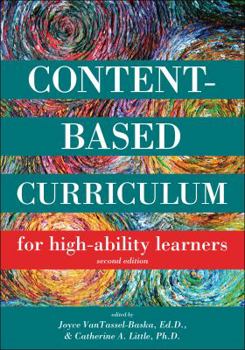Content Based Curriculum for High Ability Learners
Select Format
Select Condition 
Book Overview
The fourth edition of Content-Based Curriculum for Advanced Learners provides readers with a complete and up-to-date introduction to core elements of curriculum development in gifted education with... This description may be from another edition of this product.
Format:Hardcover
Language:English
ISBN:1593633998
ISBN13:9781593633998
Release Date:July 2010
Publisher:Prufrock Pr
Length:488 Pages
Weight:2.67 lbs.
Dimensions:10.0" x 1.5" x 7.3"
Related Subjects
Education Education & Reference Education Theory Schools & Teaching Special EducationCustomer Reviews
1 rating
Published award-winning curriculum
Published by Thriftbooks.com User , 22 years ago
Content-Based Curriculum for High Ability Learners by Joyce VanTassel-Baska and Catherine A. Little. Prufrock Press: Waco, TX 1-800-240-0333Written by recognized gifted curriculum leader VanTassel-Baska and her associates at the Center for Gifted Education at the College of William and Mary, this service publication of the National Association for Gifted Children illustrates award-winning curriculum units in language arts, social studies and science. It begins with a presentation of the Integrated Curriculum Model, which consists of an advanced content dimension, a process/product dimension, and an issues/themes dimension. Subsequent chapters cover acceleration, incorporating higher order process skills into content, concept development, and developing creative student products. The second section contains chapters on curricula for high ability learners in language arts, science, mathematics and social studies. Each chapter shows how the integrated curriculum model relates to curricular standards advanced by national organizations such as the National Science Education Standards developed by the National Research Council. The emphasis is on adaptation of existing curricula, with examples drawn from the William and Mary curriculum units. The book?s final chapters feature criteria to select appropriate content, resources and instructional strategies. A chapter on assessment deals with test reliability, validity, and authentic assessment concerns. A final chapter assists educators with aligning curricula with state standards. Because the book is very readable, it is particularly useful for educators relatively new to the field while also appropriate for experienced educators. While it does not recommend resources for curriculum decisions, the book provides solid guidelines for educators attempting to differentiate curricula for gifted learners within a diverse body of learners or within a special homogeneous classroom of gifted students.





